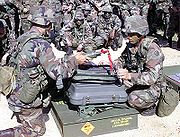
Antipersonnel Obstacle Breaching System
Encyclopedia

Mine-clearing line charge
A mine-clearing line charge is used to create a breach in minefields under combat conditions. While there are many types, the basic design is for many explosive charges connected on a line to be projected onto the minefield. The charges explode, detonating any buried mines, thus clearing a path...
system that allows safe breaching
Demining
Demining or mine clearance is the process of removing either land mines, or naval mines, from an area, while minesweeping describes the act of detecting of mines. There are two distinct types of mine detection and removal: military and humanitarian.Minesweepers use many tools in order to accomplish...
through complex antipersonnel obstacles, particularly fields of land mine
Land mine
A land mine is usually a weight-triggered explosive device which is intended to damage a target—either human or inanimate—by means of a blast and/or fragment impact....
s. The Anti-Personnel Obstacle Breaching System is joint DOD program for the U.S. Army and the United States Marine Corps
United States Marine Corps
The United States Marine Corps is a branch of the United States Armed Forces responsible for providing power projection from the sea, using the mobility of the United States Navy to deliver combined-arms task forces rapidly. It is one of seven uniformed services of the United States...
. It originated as an operational requirements document published by the US Army Engineer School, Fort Leonard Wood, MO. The joint requirements document was subsequently signed by the Army and Marines 11 April 1994. The system was developed by the US Army REDCOM-ARDEC, Picatinny Arsenal, NJ, and produced by Ensign-Bickford Aerospace and Defense. The Mk 7 Mod 1 was fielded in 2002, and the Mod 2 in 2006.
The APOBS is used to conduct deliberate or hasty breaches through enemy antipersonnel minefields and multi-strand wire obstacles. It is light enough to be carried by two soldiers with backpacks and can be deployed within 30 to 120 seconds.
Once set in place, the APOBS rocket is fired from a 35-meter standoff position, sending the line charge with fragmentation grenades over the minefield and/or wire obstacle. The grenades neutralize or clear the mines and sever the wire, effectively clearing a footpath for troops up to 45 meters in length.
The APOBS replaces the Bangalore torpedo
Bangalore torpedo
A Bangalore torpedo is an explosive charge placed on the end of a long, extendible tube. It is used by combat engineers to clear obstacles that would otherwise require them to approach directly, possibly under fire...
, which is heavier when all sections are used together, takes significantly longer to set up, and cannot be deployed from a standoff position. It also reduces the number of soldiers required to carry and employ the system to 2 (as opposed to as many as 10 or 12 for a Bangalore torpedo using all sections).
The lightweight 125-pound system includes these features:
- DelayResponse timeIn technology, response time is the time a system or functional unit takes to react to a given input.- Data processing :In data processing, the response time perceived by the end user is the interval between the instant at which an operator at a terminal enters a request for a response from a...
and command firing modes - Deployable within 30 to 90 seconds
- Deployable from a 35-meter standoff
- Clears antipersonnel mines and complex wire obstacles
- Clears a footpath 0.6 to 1.0 meters by 45 meters
As a certified insensitive munition, APOBS is safe to employ and transport.

